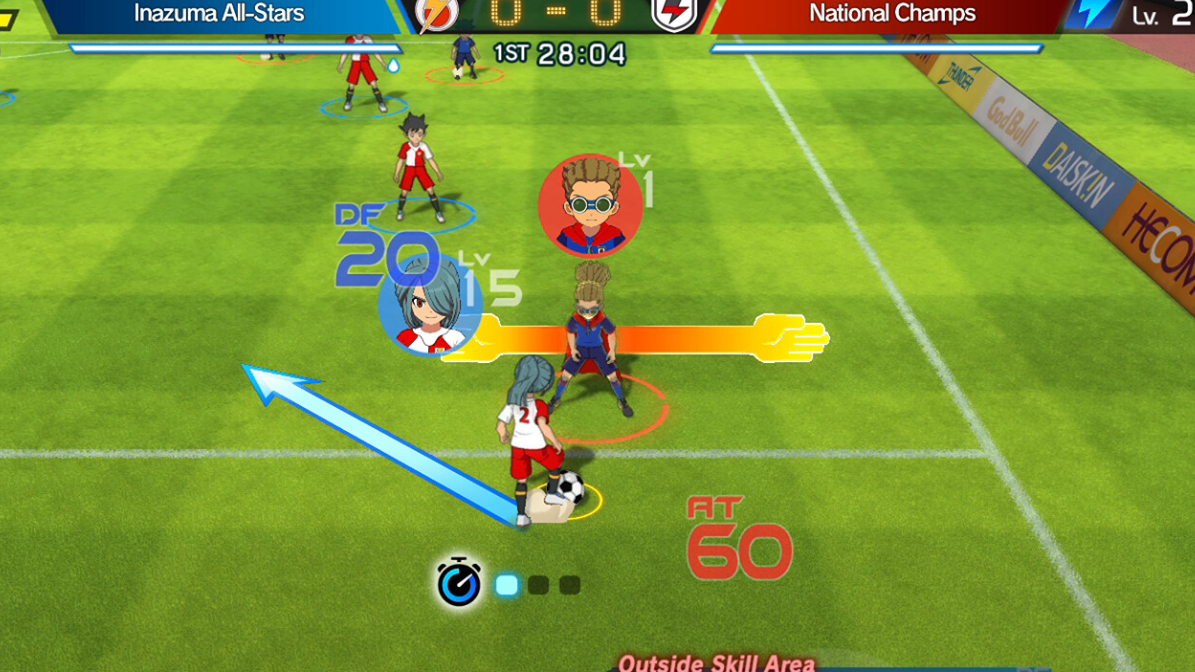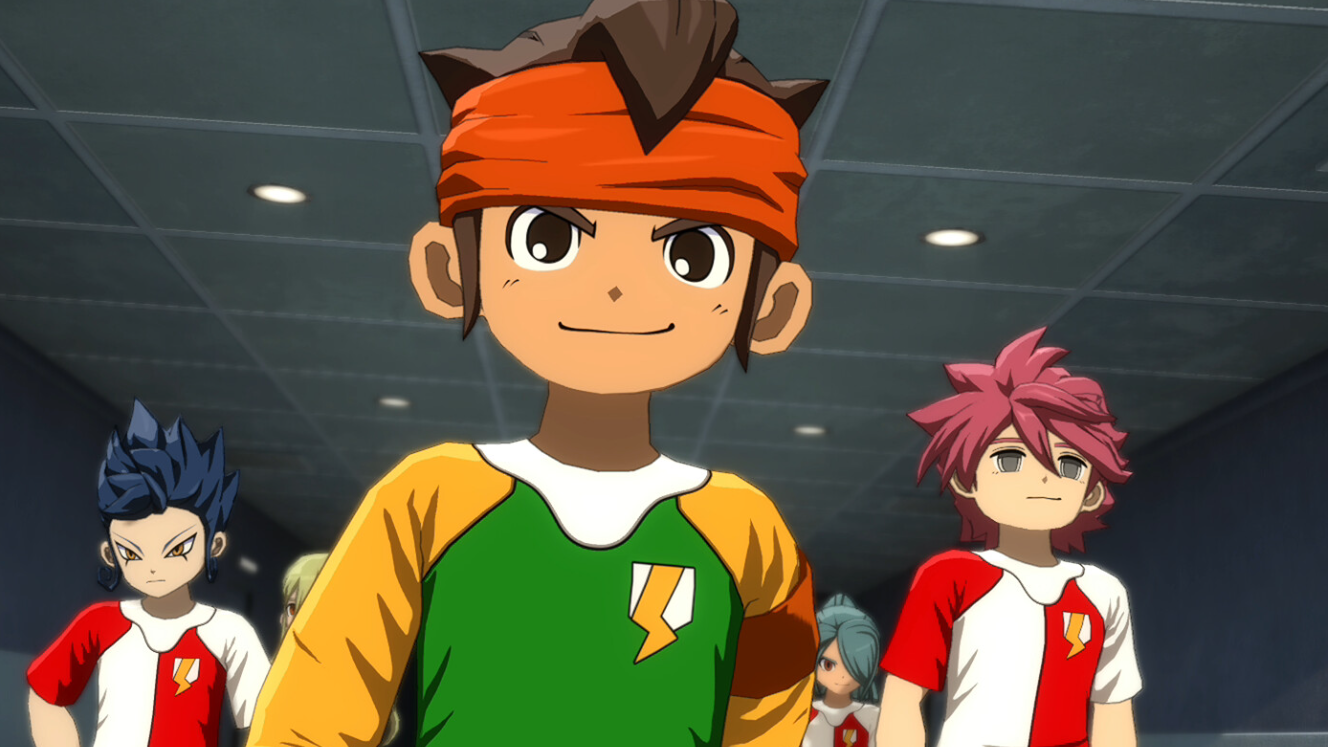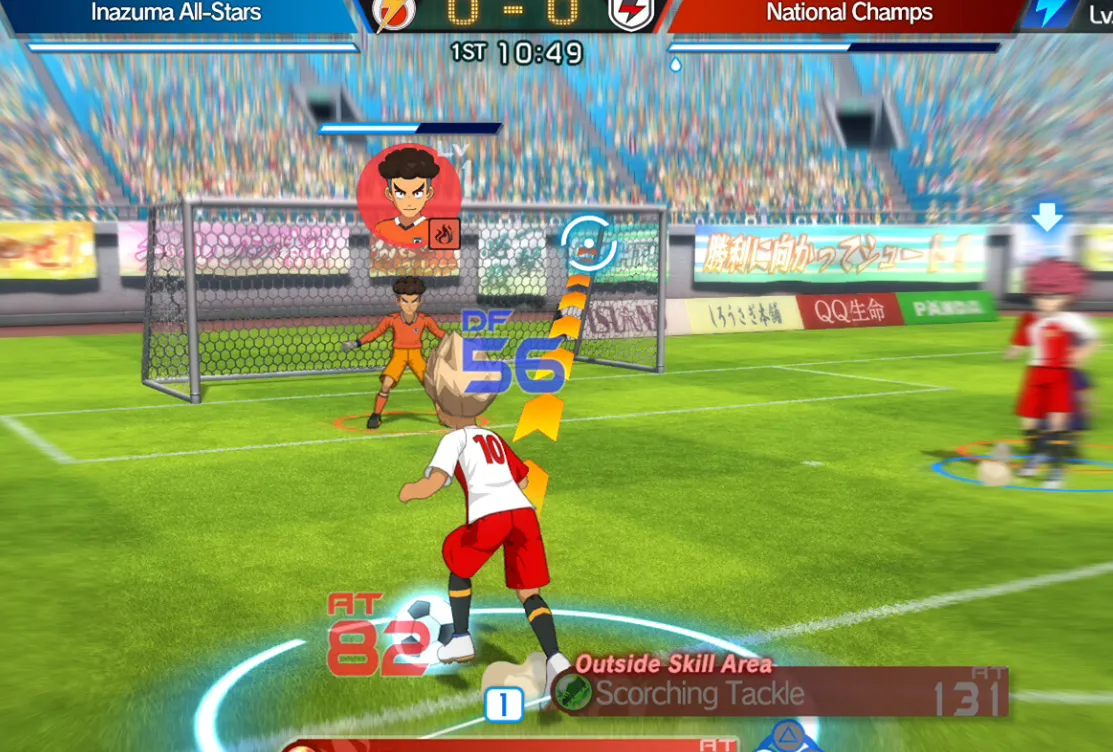Every player in Inazuma Eleven: Victory Road is defined by seven core attributes. On the formation and bio screens, these sit on a radar chart, but in matche,s they are constantly being recombined into the Attack and Defense numbers that decide every duel: shots, dribbles, scrambles, and keeper saves.
Those numbers are not random. Each interaction pulls from specific pairs or trios of stats. Once you know those links, building effective forwards, midfielders, defenders, and goalkeepers becomes much more deliberate.
All Victory Road core attributes and what they influence
| Attribute | Main idea | Key derived values it feeds | Where it matters most |
|---|---|---|---|
| Kick | Shooting power | Shot ATK, Focus Battle ATK (when shooting) | Forwards, attacking midfielders |
| Control | Ball control and touch | Shot ATK, Focus Battle ATK | Forwards, wingers, all-round attackers |
| Technique | Skill execution in Focus | Focus ATK, Focus DEF, Focus SP Move power | Dribblers, blockers, technical defenders |
| Intelligence | Game reading and positioning | Scramble ATK, Scramble DEF, Focus DEF | Defenders, defensive midfielders, goalkeepers |
| Pressure | Physical defensive presence | Scramble DEF, Castle Wall DEF, Keeper Power (KP) | Center-backs, ball-winners, defensive wings |
| Physical | Raw strength and durability | Castle Wall DEF, KP | Central defenders, goalkeepers |
| Agility | Reaction speed and quickness | KP, Focus DEF (for some duels) | Goalkeepers, mobile defenders |
On the pitch, these base stats are turned into several derived combat values. The game surfaces those in duels as “AT” (Attack) and “DF” (Defense) values depending on the context:
- Shot ATK (Shoot AT) – used when you shoot on goal.
- Focus Battle ATK / DEF – used in on-ball ground duels and Focus-based blocks or catches.
- Scramble ATK / DEF – used in aerial duels and loose-ball headers.
- Castle Wall DEF – used for defensive walls in front of the goal.
- Keeper Power (KP) – the goalkeeper’s “health bar” for saves.

How each duel type is calculated from stats
Every type of interaction has its own recipe. These are the links the game actually uses when it builds those AT/DF numbers.
| Interaction | Derived value | Stats used | What it represents |
|---|---|---|---|
| Shooting on goal | Shot ATK | Kick + Control | Power and quality of your finish |
| Dribbling or on-ball Focus duel (attacking) | Focus ATK | Technique + Control (+ Kick contribution for shot-type Focus) | How well you beat a defender on the ground |
| Block in Focus, or GK “hands size” in Focus | Focus DEF | Technique + Intelligence (+ Agility contribution for some keepers) | How reliably you stop attacks in Focus |
| Scramble when attacking (trying to receive) | Scramble ATK | Intelligence | Winning contested aerial balls as the receiver |
| Scramble when defending (trying to steal) | Scramble DEF | Intelligence + Pressure | Winning headers and loose balls as a defender |
| Castle Wall / defensive wall in front of goal | Wall DEF (Castle Wall DEF) | Pressure + Physical | How solid your wall is at blocking shots |
| Goalkeeper survivability across saves | Keeper Power (KP) | Physical + Agility (+ Pressure contribution) | How many strong shots your keeper can handle before KP collapses |
Two practical consequences fall out of this structure:
- Some stats are reused in many formulas (Control, Technique, Intelligence), so they are very efficient to invest in.
- Others are more specialized (Kick, Physical, Agility) but become critical when you lean into specific roles like pure striker or goalkeeper.
Kick, Control, and shooting stats
Shooting revolves around a small set of numbers: Kick, Control, and the Focus ATK value when shots are routed through Focus Battles.
- Kick raises the raw power behind any shot. It is always part of Shot ATK and also contributes when a shot is executed inside a Focus Battle. Higher Kick produces stronger Shoot SP Moves and better odds of overwhelming the keeper’s KP.
- Control is paired with Kick for every Shot ATK calculation. Even for a striker, ignoring Control means your shots lose a lot of their effective Attack value, especially from awkward angles or first-time finishes.
- Technique steps in once a shot becomes part of a Focus Battle. When a shot is contested in Focus, the game leans on a “Focus Battle ATK” that combines Technique, Control, and Kick.
For a forward who mostly uses normal shots, Kick and Control dominate. For one who often enters Focus before shooting or chains SP Moves, Technique quickly catches up in value.
Technique, Control, and Focus Battles
Focus is the system that handles almost all ground duels: dribbles past defenders, blocks that meet shots head-on, and many SP Moves. Here, Technique is the centerpiece.
- Focus ATK (dribbling and offensive Focus) uses Technique + Control. This governs how often an attacker slips past a defender in a Focus duel without even using a SP Move.
- Focus DEF uses Technique + Intelligence, with some situations also picking up Agility (especially for keepers). This controls how strong your blocks and Focus-based catches are.
- Focus SP Moves also scale with Technique, so high Technique boosts the ceiling of specialized dribbles, tackles, and catches.
Because Technique appears in both Focus ATK and Focus DEF and powers SP Moves, it is one of the most efficient stats in the game for players who live in dense traffic: attacking midfielders, central midfielders, and defenders who rely on blocks instead of scrambles.
Intelligence, Pressure, and Scramble duels
Scrambles cover aerial duels and contested balls knocked loose after blocks or deflections. The game separates attacking and defending in these interactions.
- Scramble ATK (trying to receive a pass or win a loose ball as the attacker) is driven by Intelligence alone. Smart forwards and midfielders with high Intelligence keep winning second balls and headed passes.
- Scramble DEF (trying to steal or clear the ball) relies on Intelligence + Pressure. Defenders who combine these two stats dominate in the air and snuff out long passes and crosses.
Pressure also has a second job: it contributes to defensive walls and Keeper Power, and it improves the success rate of raw tackles that are not wrapped in Focus.
Intelligence therefore pulls triple duty: Scramble ATK, Scramble DEF, and Focus DEF. Any defensive specialist—center-back, holding midfielder, or goalkeeper—wants a substantial Intelligence base.
Walls, Castle Wall DEF, and zonal defense
Castle Wall DEF and the “Wall DEF” concept emerge most clearly when you create defensive walls in front of the goal during the Zone phase. These values decide whether a wall blocks or weakens shots before they reach the keeper.
- Castle Wall DEF / Wall DEF is built from Pressure + Physical.
- Players with strong Pressure and Physical form walls that reliably stop or heavily blunt incoming shots.
For formations that rely on massed defending in the penalty area, like back threes with deep wingbacks, stacking Pressure and Physical on central defenders pays off twice: they excel at Scramble DEF and give you the stiffest possible Castle Walls.
Goalkeepers, Keeper Power, and “health”
Goalkeepers in Victory Road live and die by Keeper Power (KP). KP is effectively a shared resource across all of a keeper’s saves; each successful stop drains KP, and once it gets low enough, even modest shots can go in.
| Keeper-related value | Stats used | Impact |
|---|---|---|
| KP (Keeper Power) | Physical + Agility (+ Pressure) | How many and how strong shots the keeper can endure before breaking |
| Focus DEF (hands size / catch strength) | Technique + Intelligence (+ Agility) | How reliably the keeper wins direct Focus duels with shooters |
| Castle Wall DEF contribution | Physical + Pressure | How tough the last line is when the keeper is part of a wall |
Agility might seem like an odd fit compared to a more obvious “Catch” stat, but it defines how quickly the keeper reacts in Zones and Focus Battles and how well they maintain their KP pool over repeated saves.
For goalkeepers, this leads to a clear priority order:
- Agility as the primary stat for KP and reaction-based saves.
- Physical and Pressure just behind it, to shore up KP and Castle Wall DEF.
- Technique and Intelligence to win high-end Focus duels and get more out of Catch SP Moves.
Best stats by position
The position icons on the player bio screen already nudge you toward certain stat clusters. The underlying formulas make that logic explicit.
| Position | Primary stats | Secondary stats | Why they work |
|---|---|---|---|
| Goalkeeper (GK) | Agility | Physical, Pressure, Intelligence, Technique | Agility and Physical keep KP high, Pressure and Physical strengthen walls, Intelligence and Technique win Focus saves. |
| Defender (DF) | Pressure | Intelligence, Physical, Agility, Technique | Pressure and Intelligence dominate Scramble DEF, Pressure and Physical power walls, Agility helps react, Technique aids Focus blocks. |
| Offensive Midfielder / Winger (MF, advanced) | Technique | Control, Intelligence, Kick | Technique and Control win Focus dribbles, Technique boosts SP Moves, Kick matters when chaining shots from the wings. |
| Central / Defensive Midfielder (MF, central) | Intelligence | Control, Technique, Pressure | Intelligence supports both Scramble ATK and DEF and Focus DEF, while Control/Technique keep them reliable on the ball. |
| Forward (FW) | Kick | Technique, Control, Intelligence | Kick and Control maximize Shot ATK; Technique helps in Focus-based finishes, Intelligence improves scrambles and interceptions up front. |
These are starting points rather than hard rules. Hybrid roles—like a deep-lying forward who drops into midfield, or a ball-playing center-back who initiates attacks—benefit from nudging their Abilearn Board toward the mixed stats they need.
How Abilearn and Training Beans interact with stats
Level-ups raise attributes naturally, but the real fine-tuning comes from the Abilearn Board and Training Beans.
- Every player unlocks the Abilearn Board after reaching level 15.
- The board lets you choose paths that emphasize different stats and SP Move sets, effectively reshaping a player’s role.
- Training Beans are consumable items; each bean adds +1 to its matching stat when slotted into a player’s board.
- Players can equip up to three different bean types, and the cap on how many beans they can hold increases with level.
There is an important constraint: once a player becomes a Legendary or Hero rarity, any beans currently equipped to them cannot be recovered. If you plan to ascend a favorite player, unequip their beans first to avoid losing a limited resource.
Beans primarily drop from repeated matches and activities across modes, with Chronicle hero battles being a dense source. Equipment pieces add another layer of stat bonuses on top of beans and the Abilearn Board, giving you several levers to hit your desired Attack/Defense thresholds.
Rarity, leveling, and stat ceilings
Not every version of a character is built equal. Rarity governs how high the stats from all of the above systems can go.
- Regular players span a rarity ladder (Common, Growing, Advanced, Top, Legendary). Higher rarity means higher potential attribute caps across the seven stats.
- You can use beans to push a lower-rarity version up the ladder, but that burns resources that could have gone directly into stats.
- Legendary is the highest rarity reachable without entering the Player Universe gacha/shop.
- Above Legendary sit three Hero rarities. These are locked to shop/gacha acquisition rather than on-pitch progression.
Two details matter for planning builds:
- Lower rarities gain experience faster; Legendary and Hero versions take longer to level, but pay that back with higher final stats.
- Hero versions usually alter a character’s kit (different SP Moves, sometimes losing a Keshin in exchange for other tools) while also coming with a specific “build type” passive, such as Breach, Counter, Bond, Tension, Rough Play, or Justice.
Teams are limited to two Hero-rarity players on the field at once, though you can stack more on the bench. That makes Hero stats powerful, but not something you can spam across an entire starting eleven.

Putting it together on the pitch
Victory Road’s match engine is built out of these pairings and trios of stats mashed into context-specific Attack and Defense values. Once you trace those lines, the radar chart stops being abstract art and starts looking like a design tool.
Forwards want Kick and Control high enough that Shot ATK overwhelms KP; players who live in Focus want Technique and Control; defenders lean on Pressure, Intelligence, and Physical for Scramble DEF and Castle Walls; goalkeepers lean harder than anyone on Agility and Physical to keep their KP bar intact.
If you tune the Abilearn Board, beans, and equipment around those relationships, the AT and DF numbers that flash during duels stop being surprises and start looking like the scoreline you planned for.


